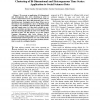Free Online Productivity Tools
i2Speak
i2Symbol
i2OCR
iTex2Img
iWeb2Print
iWeb2Shot
i2Type
iPdf2Split
iPdf2Merge
i2Bopomofo
i2Arabic
i2Style
i2Image
i2PDF
iLatex2Rtf
Sci2ools
DMIN
2006
2006
Clustering of Bi-Dimensional and Heterogeneous Time Series: Application to Social Sciences Data
We present an application of bi-dimensional and heterogeneous time series clustering in order to resolve a Social Sciences issue. The dataset is the result of a survey involving more than eight thousand more or less disabled persons. Sociologists need to know if there are in this dataset some homogeneous classes of disabled people according to two attributes: their life quality appreciation and their couple status (i.e. if they have a partner or not). These two attributes are time series so we had to adapt the k-Means clustering algorithm in order to be efficient with this kind of data. For this purpose, we use the Longest Common Subsequence time series distance for its efficiency to manage temporal gaps and we extend it to the bi-dimensional and heterogeneous case. The results of this unsupervised learning process give some pertinent clusters that are ready for sociological analysis.
Related Content
| Added | 30 Oct 2010 |
| Updated | 30 Oct 2010 |
| Type | Conference |
| Year | 2006 |
| Where | DMIN |
| Authors | Rémi Gaudin, Sylvaine Barbier, Nicolas Nicoloyannis, Maks Banens |
Comments (0)

